Chetnik war crimes in World War II
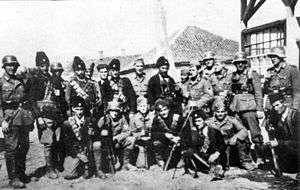
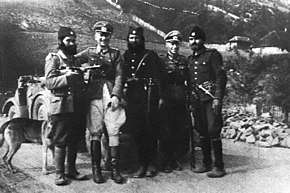
Chetniks war crimes during the Second World War were primarily directed towards the non-Serbian population of Yugoslavia (mainly Muslims and Croats) and Communist-led Yugoslav Partisans and their supporters. Since their establishment in 1903, Chetniks had been instrumental to the nationalist and expansionist politics of Serbia. They acted to preserve the centralized Greater Serbian political system within the Kingdom of Yugoslavia. The historian Vladimir Žerjavić estimates that the Chetniks killed 29,000 Muslims and 18,000 Croats over the course of the war, mostly civilians. The historian Zdravko Dizdar offers a similar figure, stating that 50,000 Muslims and Croats were killed.[1]
War crimes and violations of customs of war against Partisans
Historians Zdravko Dizdar and Mihajlo Sobolevski divided the criminal methods used by Chetniks into six categories: mass slaughter, rape, burning alive, beheading, impalement, and execution of the wounded. Other methods included hanging, killing with various objects, stoning, maiming, starving, and robbing. Forcible conversions to Orthodoxy took place in prisons such as the internment camp near Knin.[2][3]
Prisoners of war
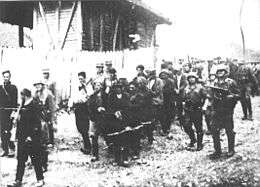
The surrender of captured Yugoslav Partisans to the Nazis occurred during the November 1941 uprising in Serbia. General Dragoljub (Draža) Mihailović's staff handed 350 captured Partisans to the Nazis, who executed them. During the Chetnik-Partisan conflict in western Serbia, the Chetniks captured over one hundred Partisans. A group of approximately 500 prisoners, including Partisans captured in the towns of Gornji Milanovac,[4] Kosjerić,[5] Karan, and Planinica, were captured by Chetniks in the Ravna Gora mountain range.
Around 13 November 1941, Chetniks took a group of 365 prisoners to the town of Mionica and then to the village of Slovac. They were brought by Nazi and Serbian collaborationist forces to the city of Valjevo. The convoy was secured by Chetnik leader Jovan Škavović Škava. The meeting between Mihailović and the Nazis in the village of Divci (at which they agreed to cooperate) preceded the Partisans' surrender. Of this group of prisoners, the Nazis executed 263 on 27 November 1941 in Krušik, Valjevo;[6][7] others were later executed, deported to concentration camps, or released.[8][9]
Partisans were executed on a regular basis: "Captured 25 Partisans and killed 24 on the site" (Miloš Erkić, commander of the Tuzla Brigade of the 58th May Corps, to the commanders of the Sember and May brigades on 24 December 1943). Telegram no. 12.425 (No. 486) of 14 December 1943 from He He (Major Radoslav Đurić, commander of the Second Kosovo Corps) reported, "We broke traitor Lieutenant Radulović and his group. Fighting was conducted by the Second Studen Brigade in the village of Gumništa, where 21 Partisans and nine captives were killed.[10]
According to the captive testimonies, Second Proletarian Division from Peko Dapčević's corps, which has three divisions, was here. This division consisted of the Second Dalmatian and Second Proletarian Divisions with around 800 people each, and the Forest Brigade with 400 (a total of 2,000). They had a lot of launchers and automatic weaponry, but little ammo. Eight of Keserović's Englishmen with Col. Seitz and a radio station joined them in Negbina. Their last portion is in Negbina and the majority in Klek. Many of their wounded died on the way. We captured 16 and slaughtered them without a court-martial.
— Telegram no. 1011 by Bi-Bi [Major Radomir Cvetić, commander of the Javor Corps]. No. 47, 21 January 1944.
The Bralenovice facility near Danilovgrad, which housed an orphanage before World War II, was used as a concentration camp for Partisans and civilians.[11] The largest imprisonments occurred in April and May 1942. As Jakov N. Jovović wrote in letter number 8 to Baja Stanišić on 30 May 1942, "489 people, ranging from one year to old men" were imprisoned in the camp. The number of prisoners was estimated at 610 in August 1942, and ranged between 700 and 1,000 at certain periods. It is estimated that Stanišić killed 426 partisans between April 1942 and September 1943.[11] Chetniks received cash rewards from the Nazis for the capture and execution of Montenegrin partisans.[12]
Medical personnel and patients
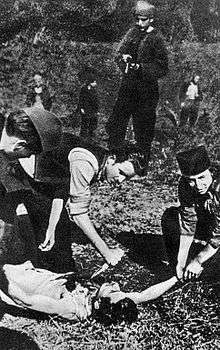
On 31 October 1941, Chetniks attacked the hospital of the Pomoravlje Partisan Detachment near the village of Ursule. This attack was part of the general attack by Nazi and Serb collaborationist units on the free Partisan territory of Levača. About ten nurses and fighters from the Levača Unit of the Pomoravlje Partisan Detachment were captured. All the prisoners were taken to Rekovac, redirected to Riljac and Ljubostinje and killed, sent to concentration camps or escaped.[13]
Chetniks attacked the Partisan hospital in the village of Gornja Gorevnica, captured eleven partisans, and killed a nurse between 4 and 5 November 1941. The prisoners were taken to Brajići, where they were sentenced to death by a court-martial; the sentence was carried out on 5 November in Brajići.[14]
On 25 March 1943, Chetnik units of the Dinaric Division were ordered to begin "cleansing (the area) of Croats and Bosniaks" and to create "one national corridor along the Dinara mountain for the connection of Herzegovina with Northern Dalmatia and Lika."[15] The Chetniks slaughtered dozens of captured partisans, including renowned Croatian poet Ivan Goran Kovačić, during the Case Black operation in June 1943.[16][17] The 1st Mountain Division reported: "Captured 498, of which 411 were executed."[18] In Cikota (eastern Bosnia) in mid-July, the Chetniks found 80 wounded Partisans from the First Proletarian Division, seized their weapons, and handed them to the Nazis. The Nazis killed them and burned their bodies.[17]
That month, Chetniks found wounded partisans from the First and Second Proletarian Brigades in Bišina and handed them over to the Nazis; the wounded partisans were later executed. Chetnik Dragutin Keserović found a partisan hospital in Jastrebac in May 1944, shooting 24 patients and four nurses. The Chetniks discovered another partisan hospital in Semberija that month, killing about 300 seriously-wounded patients. In Krčan, southeast of Udbina, about 90 seriously-wounded Partisans were hiding in 16 houses. They initially hid in the basements with fifteen nurses for ten days after Operation Morgenstern, a joint anti-Partisan offensive of the Wehrmacht, NDH forces and Chetniks in Lika. The region held from 7 to 23 May 1944. Nurses, mostly members of the League of Communist Youth of Yugoslavia from surrounding villages, carried the wounded from the basements to Krčan. A group of Partisans guarded Trnova Poljana, protecting access to Krčan, Kuke, and Visuć from Lapac. Jovo Popović knew about Partisan posts, and brought Chetniks to the village by a roundabout route. They entered Krčan on 2 June 1944 at 10 am, and killed 36 wounded partisans; women and old men hid 56 other wounded partisans. Two doctors (Croat Josip Kajfeš and an Italian named Suppa) were killed, and a Dr. Finderle was wounded.[19]
Aleksa Backović, Commissar of the 8th Kordun Division, was murdered in Obrad Radočaj's house by Popović. He was later praised by Momčilo Đujić, and received the Star of Obilić.[20]
Suspected partisan collaborators
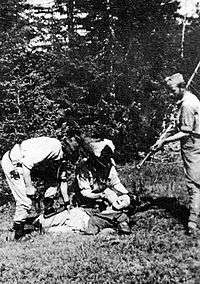
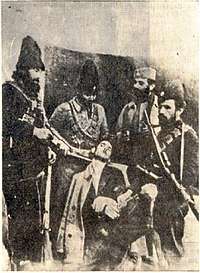
Chetniks terrorized civilians suspected of collaboration with the partisans, intimidating others to discourage partisan support. A suspect's family was often tortured for collaboration with partisans.
I have ordered the destruction of entire families, the burning of homes and entire villages where the Partisans find their strongholds because some Serbian degenerates help the proletariat scum in some villages. This is what I ordered because we lose our best nationalists due to our own degenerates.
— Telegram no. 13.007 from Georgij (Lieutenant Colonel Milutin Radojević, Mihailović's delegate for the Jablanica and Toplice Area) No. SS 58, 28 December 1943[21]
In late December 1943, Draža Mihailović ordered an anti-communist operation south of Belgrade. Colonel Jevrem Simić (general inspector of the Chetnik Detachments) and Nikola Kalabić (commander of the Chetnik Hill Guard Corps) were the main coordinators. After they signed a ceasefire-and-cooperation agreement with the Nazis in the region on 26 November 1943, Chetniks brought their units and began to clear the area.
All areas close to Belgrade are infested with communists and their supporters. I order commanders Major Mihail Jovanović, Captain Lazović, Captain Nikola Kalabić, Komarčević and the Mining Corps to be most energetic from south to north (...) in cleansing all srezs, especially Kosmaj. It is especially important to clear the srezs of Grocka and Umka. At the same time, I congratulate Captains Živojin Lazović and Nikola Kalabić. The decree was fulfilled on 1 December, and there will be further promotions for accomplishments. Continuously inform others about the actions taken.
— Mihailović's telegram to the commanders of Seged, Kiš (Živojin Lazović, commander of the Smederevo Corps), Ras-Ras (Nikola Kalabić), Dog-Dog and Romel)
Mihailović's operation lasted from 20 to 21 December. Members of the Smederevo Corps under the command of Živan Lazović killed 72 civilians, nine of whom were children from nine months to 12 years old. This became known as the Vranić Massacre. After the operation, Mihailović reported: "Terrible inactivity of the elders of Aval Corps. Živan Lazović must come so he could show what could be done."[22]
In January 1943, under Komarčević's command, Chetniks killed 72 partisan supporters in Posavina Srez. In December, Chetnik commander Živan Lazović killed 15 peasant partisan supporters. That month, Chetniks under the command of Nikola Kalabić killed 21 peasants in Kopljare and, under the command of Vuk Kalaitović, shot 18 Partisan supporters in the town of Sjenica. Chetniks under the command of Sveto Bogičević entered Sepci, where they captured Sava Sremečević, Konstantin Vojinović, Ilija Radojević and Ilija Jovanović, in August 1944. After torturing them in an attempt to extract a confession of collaboration with Partisans, they killed all four.[23]
Crimes against Muslims and Croats
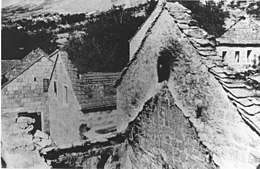
- 28 June 1941 - Chetniks killed 47 Bosniaks (mostly women and children) in the village of Avtovac, which they later looted and burned.[24]
- 27 July 1941 - Chetniks under the command of Branko Bogunović killed 62 Croats, including five women and nine children, during the Bosansko Grahovo massacre. They also robbed and burned a number of Croatian houses in Bosansko Grahovo and five surrounding villages. More than 250 Croatian men, women, and children from Obalj, Korita, Luka, Ugarci, and Crni Lug were killed. During the massacre, Chetniks tortured Catholic priest Juraj Gospodnetić and burned him alive in front of his mother.[25] Some Croats who had fled to Knin began to return to the area in early November 1941, but were blocked by Bogunović.[26]
- 13 November 1941 - According to a Knin police district report, Bogunović "threatens and slaughters Croatian people every day until he kills the last Croat because [according to him] no Croat shall live on his territory (...) On 12 November, Bogunović killed five shepherds from Luka and then took their 500 sheep, 20 cattle, and 10 horses. It's also known that a few days ago Mate Samardžija, his wife, and child went missing under Bogunović's authority (...) [Due to Bogunović], the Croatian people are forced to leave their homes and properties and run to Knin to at least save their lives".
- 12 November 1941 - Bogunović said in Sava Dešić's inn (near Kninsko Polje), "There is no salvation for the Croats, and there is no need for them to run because they cannot escape, there is no Croatian state, nor will it be, and all Croats need to be slaughtered." A significant number of Bosniaks who worked in the nearby cellulose factory were killed.[27]
- 11-13 April 1941 - Chetniks killed 17 Croats in Derventa. Between 13 and 15 April 1941, Chetniks killed 20 Croats and five Bosniaks and burned 40 houses in the area around Čapljina. On 15 April 1941, near Mostar, Chetniks killed five Croats and burned the Croatian villages of Cim and Ilići. During the Italian Fascist Operation Albia around Biokovo from 16 August to 2 September 1942,[28] Chetniks under the command of Petar Baćović committed crimes against Croat civilians (most notably in Zabiokovlje, where they killed at least 141 Croats and robbed and burned the villages of Rašćan, Kozica, Dragljane, and Župa).[29]
- 5 September 1942 - Baćović mentioned these crimes in the report to Mihailović: "(...) Additionally, I would like to add in regards to the departure of our criminal expedition in Ljubuški and Imotski, that our Chetniks (...) skinned alive three Catholic priests between Ljubuški and Vrgorac. Our Chetniks were killing all men aged 15 and above. Woman and children under the age of 15 haven't been killed. 17 villages were completely burned." During the night of 1–2 August 1941, Serbs from the Donji Lapac area rebelled against the NDH and about 2,000 Croats from Boričevac were forced to flee to Kulen Vakuf. Chetniks entered Boričevac, killed about 400 people and destroyed the village (including a Catholic church) on 2 August.[30] Crimes were also committed in Brotinja, Mišljenovac, Donji, and Gornji Lapac.[31]
- 27 July 1941 - Chetniks threw 37 Croats into a pit,[30] and killed a group of 300 Croats (who were being led by Father Waldemar Maksimilian Nestor home from a pilgrimage in Knin) at Trubar near Drvar.[32]
- 9-10 August 1941 - Chetniks massacred Croats, mostly old men, women and children (including 49 children under age 12), in Krnjeuša; Croatian homes were burned and robbed. Two hundred forty of the dead civilians were identified, including 34-year-old Catholic priest Krešimir Barišić (who was tortured and burned alive), 49 children and 72 women, a number of whom were pregnant. Chetniks also killed about 70 Croats in the neighboring village of Vrtoče, and a number of people fled to Bihać. After the massacre, Croats almost completely disappeared from the region.[33][34][35][36][37]
- September 1941 - Chetniks from Herzegovina and Montenegro killed 526 Bosniak civilians in Berkovići and Trusina. Of these, 365 were thrown alive into pits.[38] Similar cases were recorded during 1941 and the first half of 1942.
- 6 September 1941 - In Kulen Vakuf, Chetniks killed about 2,300 civilians (including old men, women and children). Most of the victims were Bosniaks; the rest (about 100) were Croats from Vrtoče, Krnjeuša, Boričevac and Bosansko Grahovo, villages destroyed by Chetniks in July and August 1941.[39]
- 7 September 1941 - Chetniks entered Dubljani, robbing and burning Croat-owned houses. Sixteen prominent Croats from Duljani and one from Prhinje were publicly hanged to discourage Croats who had fled the area not to return. Of 326 Croats recorded in the 1937 Dubljani census, 80 remained in 1948.[40]
- 1-2 October 1942 - A group of Chetniks commanded by Momčilo Đujić, Mane Rotkvić and Veljko Ilijić participated in organized retaliation against civilians in Gata and surrounding villages, killing 96 Croats.[41]
- 14–15 October 1942 - Chetniks reportedly massacred more than five hundred Croats and Muslim civilians and burnt a number of villages in the area of Prozor-Rama as part of Operation Alfa on the suspicion that the villages "harbored and aided the Partisans."[42][43] According to Croatian historian Jozo Tomasevich, incomplete data indicates that 543 civilians were killed. At least 656 victims are known by name; according to another source, 848 people (mainly "children, women, and the elderly") were killed. Historian Ivo Goldstein estimates 1,500 total deaths; the discrepancy is "due to the fact that the estimates refer to different territories." Historians Antun Miletić and Vladimir Dedijer estimated the number killed at 2,500.[44] In a report to Draža Mihailović, Chetnik commander Petar Baćović wrote that "15 Catholic villages were burnt down" and "over 2,000 Šokci (Croats) and Muslims were slaughtered."[45]
- 18 October 1942 - A report by Italian Captain Vigiaca details the crimes to Major Angel de Mateis, head of the Intelligence Department of the Italian 6th Army Corps.[46] This massacre was discussed on the Trial of Mihailović et al. by witness Aleksa Franjušić.[47]
The Partisan newspaper Borba reported that "about 2,000 souls" were "killed by the Chetniks in Croatian and Muslim villages of Prozor, Konjic, and Vakuf", and "the districts of Prozor and Konjic have hundreds of slaughtered and murdered women and children as well as burnt houses."[48] Chetnik units under Kosta Pećanac were active throughout the war in Kosovo, committing a number of crimes against the ethnic Albanian population.[49][50][51]
Genocidal crimes
Chetnik ideologists contended that ethnic cleansing of certain areas was necessary to consolidate an ethnically-"pure" Serb territory as a basis of post-war Yugoslavia. The ethnic cleansing was expected to be conducted "at a convenient moment." One of a number of documents that attest to this plan is Mihailović's written memorandum to Pavle Đurišić of 20 December 1941:[52]
The goals of our squadrons are:
- A struggle for the freedom of our people under the scepter of His Majesty King Peter II,
- To create Greater Yugoslavia and Greater Serbia within it, and ethnically cleansed Montenegro, Bosnia and Herzegovina, Syrmia, Banat and Bačka within Greater Serbia,
- A struggle for inclusion into our state life all other Slavic territories occupied by the Italians and Germans (Trieste, Gorizia, Istria and Carinthia) as well as Bulgaria and northern Albania with Shkodër,
- Cleansing the state territory from all national minorities and non-national elements,
- To create immediate common borders between Serbia and Montenegro, as well as between Serbia and Slovenia by [ethnically] cleansing Sandžak from Muslims and Bosnia from Muslims and Croats ...
The precondition for creating an ethnically-"clean" area was the destruction of the Independent State of Croatia (NDH) and ethnic cleansing of the region inhabited by Croats and Bosniaks. About Homogeneous Serbia, Stevan Moljević's discourse about his Greater Serbian program, Moljević wrote to Dragiša Vasić in February 1942:
(...) 2) Regarding our internal affairs, the demarcation with the Croats, we hold that we should as soon as an opportunity occurs, gather all the strength and create a completed act: occupy territories marked on the map, clean it before anyone pulls itself together. We would assume that the occupation would only be carried out if the main hubs were strong in Osijek, Vinkovci, Slavonski Brod, Sunja, Karlovac, Knin, Šibenik, Mostar and Metković, and then from within start with an [ethnic] cleansing of all non-Serb elements. The guilty should have an open way - Croats to Croatia, Muslims to Turkey (or Albania). As for the Muslims, our government in London should immediately address the issue with Turkey. English will also help us. (Question is!). The organization for the interior cleansing should be prepared immediately, and it could be because there are many refugees in Serbia from all "Serb lands" (...)
Written evidence by Chetnik commanders indicates that terrorism against the non-Serb population was intended to establish an ethnically-pure Greater Serbia in the historical territory of other ethnic groups (most notably Croatian and Muslim, but also Bulgarian, Romanian, Hungarian, Macedonian and Montenegrin). Mihailović went further than Moljević and requested over 90 percent of the NDH's territory, where more than 2,500,000 Catholics and over 800,000 Muslims lived (70 percent of the total population, with Orthodox Serbs the remaining 30 percent). Chetnik commander Milan Šantić said in Trebinje in July 1942, "The Serb lands must be cleansed from Catholics and Muslims. They will be inhabited only by the Serbs. Cleansing will be carried out thoroughly, and we will suppress and destroy them all without exception and without pity, which will be the starting point for our liberation."[2]
According to a March 1942 document from the Chetnik Dinaric Battalion, the primary Chetnik goal was to create a "Serbian national state in the areas in which the Serbs live, and even those to which Serbs aspire (Bosnia and Herzegovina, Lika and part of Dalmatia)" where "only Orthodox population would live". Bosniaks should realize that the Serbs were their allies, and not join the Partisans.[53] According to Bajo Stanišić, the final goal of the Chetniks was the "founding of a new Serbian state, not a geographical term but a purely Serbian, with four basic attributes: the Serbian state [Greater Serbia], the Serb King [of] the Karađorđević dynasty, Serbian nationality, and Serbian faith. The Balkan federation is also the next stage, but the main axis and leadership of this federation must be our Serbian state, that is, the Greater Serbia."[27]
The Chetnik leadership saw their "convenient moment" in January and February 1943. During this period, Chetniks commanded by Zaharije Ostojić and assisted by Pavle Đurišić and Vojislav Lukačević's units conducted extensive genocidal operations and ethnic cleansing in eastern Bosnia and Sandžak. After they finished, Đurić wrote in a report to Mihailović:[54]
To the Chief of Staff of the Supreme Command: Operations in Pljevlja, Čajniče, and Foča srezs against Muslims are completed. The operations were executed exactly as commanded. The attack started at the agreed time. All commanders and units have accomplished tasks to the general satisfaction. All the Muslim villages in the three mentioned srezs are completely burned so that none of their homes were left intact. All the property, except cattle, grains, and haylofts, has been destroyed. The collection of human and animal food for the creation of spare food storage and feeding units that remained in the field for cleaning and screening of terrain and forest areas, and for the implementation and consolidation of the organization on the liberated territory, was ordered at certain places.
During the operation, the complete destruction of Muslims regardless of sex and age was conducted.Victims totaled 22 (of which two were accidental), with 32 wounded. Of the Muslims, about 1,200 fighters and up to 8,000 other victims: women, the elderly and children.
During the initial operations, the Muslims ran towards Metaljka, Čajniče and Drina. A small part of the population found shelter in Metaljka. It's estimated that there are up to 2,000 refugees in Čajniče, and one part of it has managed to cross Drina before certain units have made cross-cutting of possible directions in that sector. The rest of population was destroyed.
The morale of the Muslims was destroyed. It was an epidemic of fear of our Chetniks, so they simply surrendered.
In late March and April 1943, the Yugoslav Partisans expelled Chetnicks from the region. The German command, equally willing cooperate with Chetnik and Muslim collaborators, later halted the operations. Chetnik planners and ideologists postponed their blueprint for the end of the war. Dragiša Vasić wrote in an April 1942 letter to Mihailović:[55]
With regard to point II b), where it is said that it is necessary to occupy the territory immediately and before anyone can get rid of the foreign element, I think that this issue should not worry us that much. I remember very well the situation Europe was in after the last war. Countries that were engaged in the war were so busy with their own internal affairs that no one, so to speak, was taking into account what others were doing within their own borders. In the first year after the end of the war, one good part of the unwanted population could simply be eradicated, and nobody would turn their heads. So, if we are smart, this issue of cleansing or reshaping and changing the population shouldn't be particularly difficult for us.
A 13 February 1943 letter from the commander of the Ozren Chetnik Corps from to the commander of the Zenica Military-Chetnik Detachment says that the source of Chetnik genocide of Croats and Muslims dates back to the 1882 creation of an independent Serbia:[27]
(...) Maybe these goals look to you and your fighters big and unrealistic. Remember great liberation struggles under the leadership of the Vožd Karađorđe. Serbia was full of Turks [Muslims]. In Belgrade and other Serbian lands, Muslim minarets were sticking up, and Turks carried out their stinky washings in front of the mosques as they are now doing in Serbian Bosnia and Herzegovina. Hundreds of thousands of Muslims flooded our homeland. Take a walk through Serbia today. Nowhere will you find neither Turks [Muslims], their graveyards nor gravestones (...) It's the best proof and the greatest guarantee that we will succeed in today's holy struggle, and that we will exhort all Turks from these Serb lands. No Muslim will remain among us (...) The villagers and other people will move to Turkey. Our government in London, through the allied and friendly government of England, seeks to achieve the consent with the Turkish government (so Churchill spoke in Ankara with Mr. İnönü). We will mercilessly destroy all Catholics [Croats] who wronged our people in these tragic days, as well as all intellectuals and economically stronger. The peasantry and the workers will be saved, and we will make them real Serbs by forcibly converting them to Orthodoxy. These are the goals of our great struggle and when the time comes we will realize them. We have already realized them in some parts of our homeland.
Trials
At the beginning of August 1945, the first public post-war trial (before the court-martial) was held in liberated Belgrade of Vojislav Lukačević and others. Public prosecutor Miloš Minić accused Lukačević of a massacre in Foča as commander of Chetnik units in Bosnia, participation in the extermination of the Muslim population, collaboration with the Nazis and Milan Nedić, and of crimes against Yugoslav Partisans. Lukačević, found guilty and sentenced to death, was executed in Belgrade in late August 1945.[56]
Chetnik leader Dragoljub Mihailović was captured on 13 March 1946 by agents of the Yugoslav Security Agency (OZNA) and indicted on 47 counts. He was convicted of eight, including crimes against humanity and high treason. Mihailović, sentenced to death on 15 July, was executed with nine other Chetnik commanders in Lisičji Potok in the early hours of 18 July 1946.[57]
See also
References
- ↑ Geiger, Vladimir "Human Losses of the Croats in World War II and the Immediate Post-War Period Caused by the Chetniks (Yugoslav Army in the Fatherland) and the Partisans (People's Liberation Army and the Partisan Detachments of Yugoslavia/Yugoslav Army) and the Communist Authorities: Numerical Indicators". Croatian Institute of History: 85–87.
- 1 2 Z. Dizdar I M. Sobolevski, Prešućeni četnički zločini u. Hrvatskoj I Bosni i Hercegovini 1941-1945. godine, Zagreb, 1999.
- ↑ Dizdar, Zdravko & Mihajlo Sobolevski: Četnički zločini na području Hrvatske i Bosne i Hercegovine 1941-1945 i 1991-95., HIC, Zagreb, 2000.
- ↑ "ZBORNIK DOKUMENATA VOJNOISTORIJSKOG INSTITUTA: TOM XIV, KNJIGA 1". znaci.net. Retrieved 16 April 2018.
- ↑ "Užička republika, Zapisi i sećanja, Narodni muzej, Užice 1981" (PDF). znaci.net. Retrieved 16 April 2018.
- ↑ "ZATAMNJENA ISTINA". znaci.net. Retrieved 16 April 2018.
- ↑ "Radoslav S. Nedović: ČAČANSKI KRAJ I NOB - SLOBODARI NA STRATIŠTIMA, Čačak 2009: Krušik, Valjevo streljanje po grupama" (PDF). znaci.net. Retrieved 16 April 2018.
- ↑ "ZATAMNJENA ISTINA". znaci.net. Retrieved 16 April 2018.
- ↑ Radisav S. Nedović. "SLOBODARI NA STRATISTIMA". znaci.net. Retrieved 16 April 2018.
- ↑ "ZBORNIK DOKUMENATA VOJNOISTORIJSKOG INSTITUTA: TOM XIV, KNJIGA 3". znaci.net. Retrieved 16 April 2018.
- 1 2 "MONTENEGRINA - digitalna biblioteka crnogorske kulture i nasljedja". montenegrina.net. Retrieved 17 April 2018.
- ↑ Zečević, Miodrag "Miodrag Zečević: Dokumenti sa suđenja Draži Mihailoviću, Beograd 2001: Saslušanje optuženih" (PDF). znaci.net. Retrieved 16 April 2018.
- ↑ Mitrović, Adam. "Levač u NOB 1941-1945, Rekovac" (1985), pg. 1985
- ↑ Poznanović, Dr. Rade; Milun Raonić & Milorad Radojčić "TRAGOM IZDAJE". znaci.net. Retrieved 16 April 2018.
- ↑ Jelić-Butić, Fikreta "CETNICI U HRVATSKOJ 1941-1945". znaci.net. Retrieved 16 April 2018.
- ↑ "Ubijen Ivan Goran Kovačić".
- 1 2 http://www.znaci.net/00001/60_3_34.pdf
- ↑ "ZBORNIK DOKUMENATA VOJNOISTORIJSKOG INSTITUTA: TOM XII, KNJIGA 3". www.znaci.net.
- ↑ Josip Grbelja, Senjski zbornik 31/2004, Rujan 1943. u Otočcu. Istina o bolnici i ranjenima, pp. 131-34 (retrieved 1 January 2018)
- ↑ Jovo Popović, Marko Lolić & Branko Latas, "Stvarnost, Zagreb" (PDF). znaci.net. 1988. Retrieved 16 April 2018.
- ↑ "ZBORNIK DOKUMENATA VOJNOISTORIJSKOG INSTITUTA: TOM XIV, KNJIGA 3". znaci.net. Retrieved 16 April 2018.
- ↑ Mihailović's telegram no. 546 to 548 for Dob-Dob and Kom-Kom, 18 January 1944.
- ↑ Miodrag Zečević, "Dokumenti sa suđenja Draži Mihajloviću, Beograd 2001: Presuda Dragoljubu Mihailoviću i ostalima" (PDF). znaci.net. Retrieved 16 April 2018.
- ↑ "GENOCID NAD BOŠNJACIMA U DRUGOM SVJETSKOM RATU" (PDF). Znaci.net. Retrieved 17 April 2018.
- ↑ "STRADANJE CRKVENIH OSOBA IZ BOSNE I HERCEGOVINE ZA II. SVJETSKOG RATA I U PORAĆU (2) - Don Antu Bakulu partizani jahali kao konja i potkovali - Povijesni feljton: Stradanja crkvenih osoba u BiH". glas-koncila.hr. 24 September 2015.
- ↑ Philip, J. Cohen (1 November 1996). Serbia's Secret War: Propaganda and the Deceit of History. Texas A&M University Press; Reprint edition.
- 1 2 3 "Četnički zločini nad Hrvatima i Muslimanima u Bosni i Hercegovini tijekom Drugog svjetskog rata (1941-1945)" (in Croatian). Retrieved 16 April 2018.
- ↑ "Operation Albia". Codenames: Operations of World War 2. Retrieved 27 September 2018.
- ↑ Milovanović, Nikola "DRAŽA MIHAILOVIĆ". znaci.net. Retrieved 16 April 2018.
- 1 2 "FOTO: SELO PREKO KOJEG SE PREVALILA ZLA KOB HRVATSKO - SRPSKIH ODNOSA Iz Boričevca su". zadarski.slobodnadalmacija.hr. Retrieved 23 July 2018.
- ↑ Komunikacije, Neomedia. "Zvona u Boričevcu oglasila se nakon 70 godina/Novi list". novilist.hr. Retrieved 16 April 2018.
- ↑ ""DAN USTANKA" - UBOJSTVO ˇUPNIKA IZ DRVARA I BOSANSKOG GRAHOVA". katolicki-tjednik.com. 10 March 2016.
- ↑ "BISKUP KOMARICA BLAGOSLOVIO SPOMEN-KRIŽ NA GROBLJU U KRNJEUŠI - KTA". ktabkbih.net. Retrieved April 17, 2018.
- ↑ (in Croatian) Marić, Franjo & Anto Orlovac, Banjolučka biskupija u riječi i slici od 1881 (2006): povodom 125. obljetnice utemeljenja Biskupije. Banja Luka: Biskupski Ordinarijat Banja Luka. pp. 477–83; ISBN 953-97841-5-8
- ↑ „Hrvati Dinare: život, opstojnost, stradanje, nauk i pouka", Zbornik radova okruglog stola održanog u Bosanskom Grahovu, 20. srpnja 1999., ed. Slavko Golijat, Split, 2000.
- ↑ Dizdar, Zdravko & Mihajlo Sobolevski, „Prešućivani četnički zločini u Hrvatskoj i Bosni i Hercegovini: 1941-1945", Zagreb (1999)
- ↑ Dizdar, Zdravko „Četnički zločini u Bosni i Hercegovini 1941-1945", Zagreb 2002.
- ↑ Skoko, Savo, Pokolji hercegovackih Srba '41. Beograd: Strucna knjiga, 1991.
- ↑ "SJEĆANJA, OPOMENE I PORUKE" (PDF). Institut-genocid.unsa.ba. Retrieved 17 April 2018.
- ↑ "Dubljani – priča o hrvatskom mjestu koje nije smjelo postojati" (in Croatian). narod.hr. 14 December 2016. Retrieved 16 April 2018.
- ↑ "Gata: vijenci za žrtve četničkog pokolja" (in Croatian). slobodnadalmacija.hr. Retrieved 16 April 2018.
- ↑ Tomasevich, Jozo, War and Revolution in Yugoslavia, 1941–1945: The Chetniks. 1 (1975), Stanford University Press: Stanford, California; ISBN 978-0-8047-0857-9, pg. 259
- ↑ Tomasevich, Jozo (2001). War and Revolution in Yugoslavia, 1941–1945: Occupation and Collaboration. 2. Stanford, California: Stanford University Press; ISBN 978-0-8047-3615-2, pg. 259
- ↑ Dedijer, Vladimir; Miletić, Antun (1990). Genocid nad Muslimanima, 1941–1945 [Genocide of the Muslims, 1941–1945] (in Serbo-Croatian). Sarajevo: Svjetlost; ISBN 978-86-01-01525-8
- ↑ Knjiga primljenih depeša štaba Draže Mihailovića, Arhiv Vojnoistorijskog instituta, četnički fond, registarski broj 1/1, kutija 280.
- ↑ Arhiv Vojnoistorijskog instituta, arhivski fond D. M., BH-X-71.
- ↑ "Miodrag Zečević: "Dokumenta sa suđenja Draži Mihailoviću: Ispitivanje svedoka i čitanje dokumenata", Beograd 2001" (PDF). Znaci.net. Retrieved 17 April 2018.
- ↑ (in Croatian) Dizdar, Zdravko & Mihajlo Sobolevski, Prešućivani četnički zločini u Hrvatskoj i u Bosni i Hercegovini 1941–1945 [Suppressed Chetnik Crimes in Bosnia and Herzegovina 1941–1945], Zagreb, Croatia: Croatian Institute of History; ISBN 978-953-6491-28-5, pg. 198
- ↑ Arhiv Kosova, Arhiv Pokrajinskog komiteta KPJ za Kosovo i Metohiju u Prištini, card no. 5, reg. no. 220
- ↑ Zbornik dokumenata i podataka o NOR-u i revoluciji, I&19, doc. no. 3
- ↑ Jovićević, Pavle. Kosovo i Metohija i odluke II zasedanja AVNOJ-a, Sloboda, November 1944.(in Serbian)
- ↑
- ↑ "Dinarska četnička divizija (4)". Hrvatski povijesni portal.
- ↑
- ↑ Milovanović, Nikola "DRAŽA MIHAILOVIĆ - SMERNICE POLITIČKOG PROGRAMA I CILJEVI RAVNOGORSKOG POKRETA". znaci.net. Retrieved 16 April 2018.
- ↑ Tomasevich, Jozo (1975), War and Revolution in Yugoslavia, 1941–1945: The Chetniks. Stanford: Stanford University Press, ISBN 978-0-8047-0857-9, pg. 427
- ↑ Buisson, Jean-Christophe (1999). Le Général Mihailović: héros trahi par les Alliés 1893–1946. Paris: Perrin.